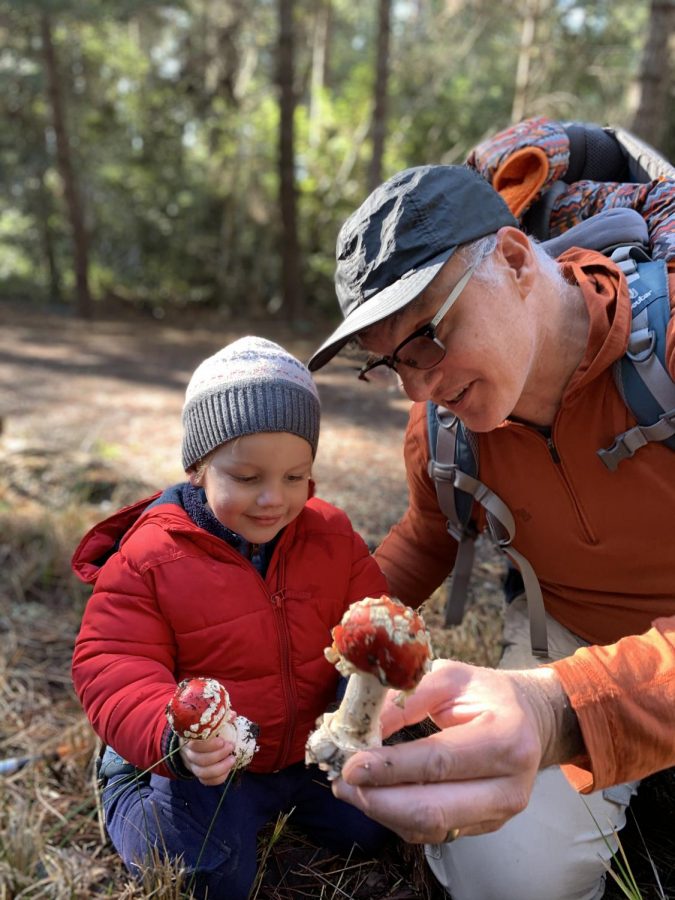Meet your teacher: Mad for mushrooms
Latin teacher explores excitement of mushroom hunting
Provided by Scott Paterson
Upper school Latin teacher Scott Paterson shows his son, Virgil, holding some Amanita Muscaria mushrooms in Jan. 2020.
March 24, 2021
Upper school Latin teacher Scott Paterson kneels in a large forest in camping gear, holding a bright red Alice-in-Wonderland mushroom with his son Virgil. He’s featured in more photos, smiling and holding mushrooms of different varieties—small and large, plentiful and single, bumpy and smooth, red and brown.
Paterson, who has been teaching at Harker for 12 years now, has enjoyed mushroom hunting for 25 years. From when he first went on a trip into the woods with some chef friends and found a huge haul of chanterelle mushrooms, he has now found many other types and has kept up with the hobby, partly due to the excitement of finding these mushrooms.
“The thing that was so great about it is there’s a real thrill. When you find a good mushroom, there’s a thrill to it. And when you find a huge stash of mushrooms, it’s really exhilarating,” Paterson said.
Paterson’s favorite place to go camping is Salt Point State Park, one of few places where mushroom collecting is allowed. Not only is it a beautiful state park, it is an excellent region to find mushrooms either to keep as specimens or to cook and eat, and he even established an annual tradition of camping there.
“Before I was married, I would go out on New Year’s Eve, [and I had a] tradition where I would go camping at Salt Point on my own for New Year’s and then on January 1, I would go into the woods and collect as many mushrooms as I could,” Paterson said.
He has also gone on multiple trips every year for 10 years now with his fellow mushroom hunter and retired Harker English teacher Dr. Ben Spencer-Cooke, who retired six years ago. They would often look specifically for chanterelles and morels, which are also some of Paterson’s favorite mushrooms to cook and eat. During these trips, Dr. Spencer-Cooke has observed the specific qualities of Paterson that make him a great mushroom hunter.
“You have to be patient, you have to be very observant, you have to concentrate, you have to move quickly to cover a lot of ground and you have to keep looking at the ground and identifying the thing you’re looking for,” Dr. Spencer-Cooke said. But [Paterson’s] always a very good companion, a fun person to go with, and of course, we make a nice trip of it.”
However, one does not need to traverse into the woods of a state park to go mushroom collecting. Sometimes, they can be found in ordinary places with nature, which Paterson also finds joy in.
“It’s also neat sometimes to just happen upon mushrooms while you’re walking about, and that’s one of the great things,” he said. Just walking through neighborhoods, I found very interesting mushrooms and bark on the side of the sidewalk. I found interesting mushrooms on campus.”
Paterson has also noted that once he became a more avid hunter, he would start scanning the ground when walking around casually, and he found many mushrooms that way.
“Each and every time I find a new species, there’s an excitement about it, and I can remember the first time I found a porcine, and I can remember the first time I found a morel and I can remember the first time I found this and that; there’s something neat about finding new types of mushrooms,” Paterson said.
One reason that Paterson has kept with the hobby is because of his love for mushrooms and nature overall. He finds it humbling that there are some mushroom species that cannot be cultivated artificially by humans: they can only be found in the wild.
“I found [a mushroom] with my son earlier this season when we were out on a walk called an earth star. And it looks like a little ball with petals on it,” Paterson said.
As a Latin teacher, Paterson also enjoys studying the etymology of mushrooms’ scientific names. For example, the Amanita muscaria, a round red mushroom with white spots, comes from the Latin word mosca. According to legend, Romans would break up the mushrooms and put them in liquid to attract flies, where they would be stunned and killed. Thus, Paterson can connect his hobby to his passion for Latin as well.
Over the years, Paterson has found many different species of mushrooms and has developed a list of some of his all-time favorites such as the cauliflower mushroom, Sparassis crispa, for eating, as well as most unique he has come across, including the latticed stinkhorn mushroom, Clathrus ruber. He also has become familiar with the times of the years that specific mushrooms will grow, and he shares them for beginner mushroom hunters.
“Fall mushrooms are chanterelles, porcinis; winter mushrooms would be hedgehogs, black trumpets and yellow foot chanterelles; and spring mushrooms would be morels. Oftentimes, you can find spring porcinis as well,” Paterson said.
Apart from the thrill of finding different mushrooms, Paterson’s love for nature and the outdoors will keep him mushroom hunting in the future, and perhaps with his sons.
“[It is] a reason to get out in the woods, whether you find that mushroom or not. You get to spend the day walking through the woods, and that’s always a good thing,” Paterson said. “And just to see these amazing things that nature produces is really just a great thing. I really enjoy that aspect of it.”


















![“[Building nerf blasters] became this outlet of creativity for me that hasn't been matched by anything else. The process [of] making a build complete to your desire is such a painstakingly difficult process, but I've had to learn from [the skills needed from] soldering to proper painting. There's so many different options for everything, if you think about it, it exists. The best part is [that] if it doesn't exist, you can build it yourself," Ishaan Parate said.](https://harkeraquila.com/wp-content/uploads/2022/08/DSC_8149-900x604.jpg)




![“When I came into high school, I was ready to be a follower. But DECA was a game changer for me. It helped me overcome my fear of public speaking, and it's played such a major role in who I've become today. To be able to successfully lead a chapter of 150 students, an officer team and be one of the upperclassmen I once really admired is something I'm [really] proud of,” Anvitha Tummala ('21) said.](https://harkeraquila.com/wp-content/uploads/2021/07/Screen-Shot-2021-07-25-at-9.50.05-AM-900x594.png)







![“I think getting up in the morning and having a sense of purpose [is exciting]. I think without a certain amount of drive, life is kind of obsolete and mundane, and I think having that every single day is what makes each day unique and kind of makes life exciting,” Neymika Jain (12) said.](https://harkeraquila.com/wp-content/uploads/2017/06/Screen-Shot-2017-06-03-at-4.54.16-PM.png)








![“My slogan is ‘slow feet, don’t eat, and I’m hungry.’ You need to run fast to get where you are–you aren't going to get those championships if you aren't fast,” Angel Cervantes (12) said. “I want to do well in school on my tests and in track and win championships for my team. I live by that, [and] I can do that anywhere: in the classroom or on the field.”](https://harkeraquila.com/wp-content/uploads/2018/06/DSC5146-900x601.jpg)
![“[Volleyball has] taught me how to fall correctly, and another thing it taught is that you don’t have to be the best at something to be good at it. If you just hit the ball in a smart way, then it still scores points and you’re good at it. You could be a background player and still make a much bigger impact on the team than you would think,” Anya Gert (’20) said.](https://harkeraquila.com/wp-content/uploads/2020/06/AnnaGert_JinTuan_HoHPhotoEdited-600x900.jpeg)

![“I'm not nearly there yet, but [my confidence has] definitely been getting better since I was pretty shy and timid coming into Harker my freshman year. I know that there's a lot of people that are really confident in what they do, and I really admire them. Everyone's so driven and that has really pushed me to kind of try to find my own place in high school and be more confident,” Alyssa Huang (’20) said.](https://harkeraquila.com/wp-content/uploads/2020/06/AlyssaHuang_EmilyChen_HoHPhoto-900x749.jpeg)












